China To Engage In 'Six Inevitable Wars' Involving U.S., Japan, India And More, According To Pro-Government Chinese Newspaper
A map released by state-run Xinhua News Agency, which marks the newly established Air Defense Identification Zone, which includes disputed areas in the East China Sea. Xinhua China's announcement last weekend of an Air Defense Identification Zone, which includes disputed areas of the East China Sea, has ratcheted up tensions between China and her neighbors, leading some to believe war is imminent. The new air defense area includes the airspace above the hotly disputed cluster of tiny islands known as the Diaoyu to China and the Senkaku to the Japanese. International reaction to the ADIZ, particularly from Japan and its ally the U.S., has been uniformly defiant. In addition to official statements from Japanese Foreign Minister Fumio Kishida and U.S. Secretary of Defense Chuck Hagel, Reuters reported Tuesday that two U.S. military aircraft have flown around the disputed islands in direct defiance of China’s ADIZ. “We have conducted operations in the area of the Senkakus,” spokesman Col. Steve Warren said, using the Japanese name for the islands. In addition to declaring the zone’s wide boundaries, Chinese military forces announced that all air travel in the designated ADIZ must be reported to avoid “emergency defensive measures in response.” The U.S. did the flyover without addressing the demands made by China. “We have continued to follow our normal procedures, which include not filing flight plans, not radioing ahead and not registering our frequencies,” Warren continued. The new ADIZ has brought added tension to one of China’s several current territorial disputes. As pointed out in Shanghai-based news-blog, The Shanghaiist.com, earlier this summer, a particularly strident pro-government local newspaper, Weweipo, published a war-mongering article describing the “Six Wars China Is Sure to Fight In the Next 50 Years.” The article essentially predicts that most of China’s current border disputes will eventually lead to war. Over the next 50 years, the article expects China to be engaged in war over the following issues: 1. Taiwanese unification (2020-2025) While China and Taiwan currently have fairly peaceful relations, the mainland continues to strive for “unification.” 2. South China Sea islands (2025-2030) According to a translation of the original article, as published by StratRisk.com, following the inevitable "return" of Taiwan, “South East Asian countries” will “already be shivering.” This momentum will be the driving force behind negotiations to “reconquer” South China Sea islands like the Spratlys, which neighboring governments like Taiwan, Malaysia, the Philippines and Vietnam all lay claim to. 3. “Southern Tibet" (2035-2040) Though China and India share a long border along China’s southwest region, a Himalayan area claimed as "southern Tibet" is the main point of contention between the two huge nations. The article suggests that “the best strategy for China is to incite the disintegration of India” by dividing the nation into several smaller countriesso “India will have no power to cope with China." 4. East China Sea islands (2040-2045) Unsurprisingly, the newspaper reaffirms that the East China Sea island groups of Diaoyu and Ryukyu, known in Japan as Senkaku and Okinawa, belong to China. While the article says the conflict won’t take place until 2040, other scholars have estimated that a war between China and Japan, and likely the U.S., could happen sooner. 5. “Outer” Mongolia (2045-2050) “If Outer Mongolia can return to China peacefully, it is the best result, of course; but if China meets foreign intervention or resistance, China should be prepared to take military action,” the article reads. 6. “Recover the territory seized by Russia” (2055-2060) The article recognizes the current good relations between China and Russia but insists that “China never forgets the lands lost to Russia” in past centuries, adding that “when the chance comes, China will take back the lands.” The article is predictably confident that all wars would be won by the Chinese side, and Russia is no different: “After the victories of previous five wars, it is time to make Russians pay the price.”
Japanese Defense Minister Itsunori Onodera (L) inspects a guard of honor in New Delhi on January 6, 2014.
Japan's Prime Minister Shinzo Abe (L) and his Indian counterpart Manmohan Singh shake hands after addressing the media at Hyderabad House in New Delhi January 25, 2014. (Reuters/Adnan Abidi) Three major concrete deliverables emerged during Japanese Prime Minister Shinzo Abe’s state visit to India, and in all three China is revealed to be a Shakespearean Banquo’s Ghost in the India-Japan discourse. First and foremost, the India-Japan Global and Strategic Partnership, which hitherto was largely confined to Japanese assistance in infrastructure projects in India, is now set for a push in the political aspects of the bilateral relationship with security and strategic overtones. This is clear by the decision of the two prime ministers – Abe and his Indian counterpart, Manmohan Singh – to have an institutionalized mechanism of regular consultations between the two sides’ national security advisors. Unlike India, Japan does not have a post of National Security Advisor; therefore, the Secretary-General of National Security Secretariat of Japan (the equivalent of India’s NSA) will be the point person for holding talks with the Indian NSA. Two, India has taken an unambiguous position for the first time on the recent Chinese policy of declaring an Air Defense Identification Zone (ADIZ), which has been stiffly opposed and defied by powers including Japan, South Korea and the Philippines. A joint statement released at the end of delegation-level talks between Singh and Abe in New Delhi on January 25, clearly stated: “The two Prime Ministers underscored the importance of freedom of overflight and civil aviation safety in accordance with the recognized principles of international law and the relevant standards and recommended practices of the International Civil Aviation Organization (ICAO).” This is a bold foreign policy move by the Indians, especially when China had clarified shortly after its introduction of the ADIZ dispensation that India was out of its ambit. It shows that New Delhi has finally mustered enough gall and courage to side with Japan at the expense of China on the ADIZ controversy. In a sense, this is India’s way of squaring up with the Chinese for the discriminatory Chinese policy of issuing stapled visas for Indians domiciled in the Indian states of Jammu and Kashmir and Arunachal Pradesh. By the stapled visas policy, the Chinese had taken sides with Pakistan at the expense of India. Three, India and Japan decided to put a deeper emphasis on military-to-military exchanges and joint exercises and prepared an ambitious roadmap in this regard. Singh and Abe underscored the importance of such exercises and decided to hold these with increased frequency. Indian Navy (IN) and the Japan Maritime Self-Defense Force (JMSDF) held the second bilateral exercise in December 2013 off the coast of Chennai and will now have its next edition in the Pacific Ocean in 2014. The focus on the Indo-Pacific is unmistakable. Abe has been a vocal supporter of India’s increased presence in the Pacific – another red rag for China.
Japan's Prime Minister Shinzo Abe (C) speaks with Indian Vice President Hamid Ansari as his wife Akie (R) and Indian Prime Minister Manmohan Singh (2nd L) look on, while attending the "At Home" reception at the Rashtrapati Bhavan presidential palace after the Republic Day parade in New Delhi January 26, 2014. (Reuters) Besides these three concrete deliverables off the Singh-Abe talks on January 25, it is work in progress on two other recent high points in the India-Japan narrative: Japan’s sale of US2 amphibian aircraft to India and a civilian nuclear cooperation agreement. On the former, the two sides have already held the first meeting of the joint working group in New Delhi in December 2013 and the second meeting of the group is scheduled to be held in March 2014 in Japan. This is for the first time that Japan has agreed to sell an equipment of potential military use to a foreign country. On the latter, the two prime ministers “directed their officials to exert further efforts towards an early conclusion” of the nuclear deal, the joint statement said. These are tricky and complicated negotiations and will take months, possibly years, for signing the nuclear deal. Indo-Japan relations have gone from strength to strength in recent years. In fact, Japan is the only country in India’s foreign policy outreach in the past one decade with which India’s relations have constantly been on an upswing. Not even Russia, India’s closest and traditional strategic partner, can boast of this track record. India’s relations with Japan have begun to take the flavor of India’s relations with Russia and the US where the two sides are cooperating on virtually everything under the sun – defense, energy, nuclear, trade, investment, science and technology, infrastructure, health, people-to-people contacts, railways, cyber security and tourism, apart from political and strategic issues. Abe’s visit was preceded by a visit to India by Japan’s Emperor and Empress (November 30-December 6), the first ever in the 2,600-year history of the monarchy in Japan. This was followed by Defense Minister Itsunori Onodera’s visit to India last month – the first such visit by a Japanese defense minister. India’s defense minister will be traveling to Japan later this year.
Japan's Prime Minister Shinzo Abe (centre R) waves as he walks with Indian President Pranab Mukherjee (centre L) as they leave after attending the Republic Day parade in New Delhi January 26, 2014. (Reuters) The increasing India-Japan bonhomie will be a headache for China and a major succor for the United States. India, Japan and the US have been having a Trilateral Dialogue on security issues since November 2011. China cannot be oblivious to the fact that Japan and India (Asia’s number two and three economies, respectively) are getting closer at a time when Abe is trying to restore ‘Japan’s pride,” not unlike what Vladimir Putin has done for Russia. Abe has recently declared the “Restoration of Sovereignty Day” to mark April 28, 1952 (the date when the Allied occupation after Second World War ended); changed Japanese post-war constitution’s pacifist nature by reinterpreting Article 9; and introduced a highly controversial national secrecy law. STORY HIGHLIGHTS
Editor's note: Geoff Hiscock is a former Asia business editor of CNN.com and the author of "Earth Wars: The Battle for Global Resources," published by Wiley. (CNN) -- Japanese Prime Minister Shinzo Abe's intended presence as chief guest of honor at India's Republic Day parade in New Delhi on Sunday symbolizes the significance India places on an ever-closer relationship with Japan in their mutual quest to counter the economic and strategic might of China. Abe, whose Defense Minister, Itsunori Onodera, was in India earlier this month for talks on expanded bilateral defense cooperation, will see some of India's latest military hardware on display in the traditional parade, including its nuclear-capable long-range missiles, the Agni 4 and Agni 5. India successfully tested a 4,000-km range Agni 4 on January 20 from its Wheeler Island launch site in the Bay of Bengal. Republic Day is the most high-profile event on the Indian political calendar, and the government makes a point of inviting leaders from countries with whom it seeks to cultivate closer ties. Chief guests in recent years have included the presidents of Indonesia and South Korea, for example. Last month, India and Japan held their first bilateral naval exercise in Indian waters off the coast of Chennai, following on from a similar exercise in Japanese waters in June 2012. The two sides have also taken part in the multilateral "Malabar" naval exercises in recent years, joining US, Australian and Singaporean ships. Territorial disputes
Japan and India, the second and third-biggest economies in Asia behind China, both have an uneasy relationship with Beijing. Tensions between Japan and China are running high over territorial disputes in the East China Sea centered on the Senkaku/Diaoyu islands, and over the controversial December 26 visit by Abe to the Yasukuni Shrine, the Tokyo site regarded by China, North Korea and South Korea as a symbol of Japan's imperial military past and honors war criminals. India and China fought a brief border war in 1962 and had a serious military standoff last April when India alleged that Chinese troops crossed into Indian-held territory near Ladakh in the Himalayan mountain range. China denied any incursion. There were further incidents in July near Ladakh and in August in Arunachal Pradesh, the northeastern Indian state where China also has laid claim to territory. Since then, Indian Prime Minister Manmohan Singh and Chinese Premier Li Keqiang have pledged "maximum restraint" on border issues. They vowed not to seek "unilateral superiority" along the 3,500-km border when they signed an agreement in Beijing last October. Japan -- and Abe in particularly -- has long regarded India as a powerful counterweight to China's strategic rise in the Indo-Pacific region. In his 2007 book "Towards a Beautiful Country: My Vision for Japan," Abe singled out India for special attention, writing that it would not surprise him if "in another decade, Japan-India relations overtake Japan-U.S. and Japan-China ties." China-Japan trade That goal looks improbable -- at least on the economic front. Japan's $340 billion of annual two-way trade with China dwarfs its $20 billion trade ties with India -- a consequence of the many Japanese businesses based in China -- but India has long been the biggest recipient of Japanese development aid and both sides are keen to grow business and investment ties. During Abe's upcoming visit, he and Singh are expected to discuss Japanese investment and assistance for the Delhi-Mumbai Industrial Corridor and other infrastructure projects such as the Mumbai Metro. Japan is also keen to sell its unique ShinMaywa US-2 search and rescue seaplane to the Indian defense forces. Asked at a press conference in New Delhi on January 6 about Chinese concerns over the proposal, Japanese Defense Minister Onodera said he believed China was probably the world's biggest exporter of weapons. "I feel there is an incongruity that China, which sells lots of weapons globally, is concerned about Japan's attempt to export the US-2, which is not even a weapon but just a seaplane. I speculate that the international community has the same view as ours," he said. Mistakes of past Abe, who became Japanese prime minister in December 2012 -- a role he also held in 2006-07 -- has shown an assertive style in his attempts to rebuild Japan's economic and military status in the Indo-Pacific region. His approach prompted sustained criticism from China during 2013, urging Japan to "adopt a correct attitude" and reflect on the mistakes of its militaristic past. Predictably, Abe's December 26 visit to Yasukuni Shrine evoked strong reactions from both China and South Korea. Chinese Foreign Ministry spokesperson Hua Chunying said on January 9that Abe, by his actions and words, had "shut the door" on dialogue with the Chinese side. "It shows that he does not have even the slightest interest in improving relations with China and other Asian neighbors," Hua said. For China, a warmer relationship between Japan and India is just another indicator of what it regards as a U.S.-led attempt to encircle or contain China. In its view, the Obama administration's "Asian pivot," with its enhanced military cooperation with countries such as Japan, Australia and the Philippines, is a vehicle to delay or derail China's natural ascension as the preeminent Asian power. Asian Aircraft Carrier Race -- China Vs. India Vs. Japan
Tugboats guide the Vikrant as it leaves the dock of the Cochin Shipyard after the launch ceremony in Kochi AFP/Getty Images via @daylife) What is it about aircraft carriers that just about any nation of supersize and heft has to have one? That’s the question after the launch over the past week of two aircraft carriers by nations on either side of China – that is, India, to the south and southwest and Japan to the east. The Indian aircraft carrier won’t actually be able to do anything for real for another five years while the Japanese carrier is supposedly just a large destroyer with an outsized flight deck. The Japanese say that’s big enough for only 14 helicopters, but it sure looks as if it’s intended for fixed-wing aircraft as well. Nobody’s predicting that either of these mighty warships will go into battle in the near future. Still, the Japanese carrier, or destroyer, does appear as a response to China’s lone aircraft carrier, a discard from the Ukraine that was rebuilt in China but isn’t carrying planes except for testing and training. Discreetly, the Japanese aren’t boasting much about the 19,500-ton Izumo, which should be ready for action in two years, but Japan’s success in producing such a vessel may diminish the Chinese challenge to Japanese control over the disputed Senkaku islands, Diaoyu to the Chinese. No one doubts that Japanese shipyards, after decades producing some of the biggest, most sophisticated commercial vessels, could turn out still more in the Izumo class – and go up in class to full-fledged aircraft carriers. At the same time, India is trumpeting Monday’s launch of the 37,500-ton Vikrant as its first “indigenous” aircraft carrier, entirely engineered and produced in India at a shipyard in Cochin on the southeastern coast, but this vessel is far from functional. Yes, it’s safely in the water, to the din of a traditional band and Sanskrit chants, christened by the wife of defense minister A.K. Antony when she broke a coconut on the bow, but basically it’s a shell awaiting a flight deck, bridge and much else. As for China’s carrier the Liaoning, the new name of a Soviet Navy ship that was launched 25 years ago, it’s been rebuilt and sailing around the Yellow Sea for more than a year, but it’s relegated to the role of a training vessel. Chinese shipyards are expected to try to produce home-made models in the next few years, advancing on much the same technology. At 55,000 tons, the Liaoning’s got a flight deck 999 feet long – not all that much longer than the 860-foot flight deck of the Vikrant or the 814-foot flight deck of the Izumo– and can carry maybe 50 fighter planes compared with 36 on the Vikrant. (The Japanese, of course, don’t say how many planes the Izumo might carry since, remember, it’s not supposed to carry any planes at all.)
China's first aircraft carrier, the 'Liaoning,' berthed at the naval base in Dalian, northeast China's Liaoning province.(AFP/Getty Images via @daylife) China is obviously upset about the competition, especially from Japan, always seen as looking for an excuse to return to the days of Japanese imperialism that ended 68 years ago this week with the Japanese surrender on August 15, 1945. The Japanese have built hundreds of enormous merchant ships but no military vessel nearly as large as the Izumo since the “Pacific War.” For India, not known as a ship-building nation despite its long coastlines, the launch of the Vikrant, meaning “courageous,” is a matter of intense pride. “A proud moment for Indian Navy,” headlined The Hindu, a major national newspaper. “In Elite Club,” said a subhead. “Indigenous” and “indigenization” are words that come up regularly in reports of the launch. It’s as though Indians are overjoyed not to have to describe the ship as “Indianized” via “Indianization” – terms for converting three other carriers, two that began life in the British Royal Navy and a third that’s arriving soon from the Russian navy. “India will join a select club of four nations – U.S., UK, France and Russia – that have the capability to build and operate warships of this size,” said The Indian Express EXPR -0.54%, another national newspaper, despite “a long road ahead” before the ship is completed, has undergone sea trials and is ready for duty. Actually, India has much more to do than that if the ship is fit for war – for instance against Pakistan. The new Vikrant will not go to war without destroyers for protection and tenders and supply vessels to keep it fueled and its 1,500-man crew adequately fed, but India’s first carrier, also named the Vikrant (the Hercules during its Royal Navy days, now a floating museum in Mumbai), came in handy in the Indo-Pak War more than 40 years ago. .
Crew members of Japan's newest warship, the Izumo. during launch ceremony in Yokohama on August 6, (AFP/Getty Images via @daylife) But where is the arms race in aircraft carriers really going? How can India justify the investment of more than $5 billion in an aircraft carrier against other priorities ranging from food and health to defense on its land borders with Pakistan and China? The question seems all the more relevant as U.S.carriers more than twice as large roam the region’s waters. If the aircraft carriers of China, Japan and India ever go to war, it’s a safe bet that the George Washington and Ronald Reagan, nearly 100,000 tons each, will be throwing their weight around. And that’s to say nothing of a new class of supercarrier beginning with the Gerald R. Ford, due for launch this year. Japanese Prime Minister Shinzo Abe’s recent visit to Manila has galvanised Japan’s strategic partnership with the Philippines. The two countries have come together in reaction to China’s assertiveness, and because of converging economic imperatives. Standing together with Philippine President Benigno Aquino, Abe announced that Tokyo and Manila would expand the scope of their maritime and economic cooperation. Tokyo will extend a stand-by credit loan for the Philippines’ disaster preparedness and offer continuous assistance to the Mindanao peace process, among other initiatives. When it was created in 2011, the purpose of the Japan–Philippines Strategic Partnership was simply to facilitate the exchange of goods, services, people and investments between the two economies through the implementation of the Japan–Philippines Economic Partnership Agreement. But ever since Abe was elected, the relationship has shifted focus to maritime security cooperation. So it was no surprise when Prime Minister Abe promised 10 patrol vessels to the Philippine Coast Guard through a loan agreement. In itself, this should not alarm anyone. Both the Philippines and Japan are maritime nations who want to ensure maritime security and freedom of navigation in the region’s vital Sea Lines of Communication. In context, however, this cooperation can be seen as a clear response to a common threat — China’s maritime build-up in the East and South China Seas. The relationship with Japan is just one element in the Philippines’ broader strategy: to intensify defence cooperation with its allies to compensate for its limited military capability and insecurity. Manila’s multilateral approach to security in the South China Sea is also a bid to counter Beijing’s insistence on bilateralism, which may legally and strategically undermine Manila’s territorial claims. This is why President Aquino will give the United States and Japan access to the Subic Naval Base, a former US military facility facing the South China Sea. Japan, too, gains from increased cooperation. The Philippines will play a role in Japan’s nascent defence strategy of deploying Japanese marine troops and surveillance drones to protect its remote islands in the East China Sea. Also, a better relationship with the Philippines fits in with Japan’s foreign policy strategy of re-engaging ASEAN. But Japan cannot be an effective counterweight to China on its own. China is not likely to be intimidated. It is only the United States, still the dominant Pacific power, which can guarantee peace and stability in the Asia-Pacific through its military presence. Still, the revitalised partnership will be useful, and it is not just about counter-balancing China. Prime Minister Abe and President Aquino pledged to bolster economic cooperation at a time when both Japan and the Philippines are undergoing an economic renaissance and gaining international confidence by combining fiscal stimulus with economic reform. But the Japanese government knows its economy needs closer ties with vibrant ASEAN countries if reforms are to succeed. As the fastest-growing economy in the region, the Philippines offers a competitive investment destination and a lucrative market for Japanese companies, who are looking elsewhere than China in light of anti-Japan protests, which disrupt business. On the other hand, President Aquino thinks Japan can be a major driver of the Philippines’ future economic growth. His administration is turning to foreign direct investments (FDI) to expand the manufacturing sector. In 2012, Japan was the Philippines’ largest trade partner, with roughly US$16 billion in total bilateral trade, and the second-biggest source of FDI. Prime Minister Abe’s visit is seen as catalysing Tokyo’s support for President Aquino’s key programs in infrastructure development, disaster preparedness, and the Mindanao peace process through official development assistance. Japan is the leading source of such aid to the Philippines and it has poured money into Mindanao, where the Philippine government has been negotiating for a comprehensive peace pact with the Moro Islamic Liberation Front. Aquino clearly wants a final peace accord to form part of his legacy, and Japan has contributed significantly to the process through its development projects under the framework of the Japan–Bangsamoro Initiative for Reconstruction and Development, or J-BIRD. During Abe’s visit, Philippine survivors of Japanese military sexual slavery during World War II urged Aquino to bring up their demand for official apology. But President Aquino did not delve into the issue of comfort women and even suggested that the Philippines has moved on from its historic conflict with Japan. The Philippine government has said previously that it would back a rearmed Japan shorn of its pacifist constitution to counter-balance China in the Asia Pacific. Japan’s and the Philippines’ strategic and economic interests are converging. Their relationship is no longer defined by the bitter memories of brutal Japanese occupation. Instead, their priorities are to ensure economic growth and counter China’s assertiveness.
| A long-standing conflict over the sovereignty of a group of eight tiny, uninhabited islands in the East China Sea has resulted in dozens of anti-Japanese protests across China, some violent. The dispute came to a head after the Japanese government nationalized control of three of the largest islands earlier this month, purchasing them from a private Japanese family for more than US$25 million. The island group is called Senkaku Islands by the Japanese, Diaoyu Islands by the Chinese, Tiaoyutai Islands by Taiwanese, or the Pinnacle Islands by English speakers. Beyond national pride, potentially large gas reserves and fishing rights have raised the stakes, and China is now moving to assert its claim to the islands, contain the demonstrations at home, and respond forcefully to what it sees as a major Japanese provocation. An anti-Japan protester tears Japanese Rising Sun Flag during a rally outside the Japanese Consulate General in Hong Kong as they demanded that the Japanese government release Chinese activists arrested in Japan after landing on Uotsuri Island, one of the islands of Senkaku in Japanese and Diaoyu in Chinese. (AP Photo/Kin Cheung)
Uotsuri island, part of the disputed islands in the East China Sea, known as the Senkaku isles in Japan, Diaoyu islands in China, in the East China Sea, in this June 19, 2011 photo. Uotsuri is the largest of the island group, with an area of 4.32 square kilometers.(Reuters/Kyodo) #
Thousands of Chinese protesters take part in a demonstration in Chengdu, Sichuan province against Japan's claim of the Diaoyu islands, as they are known in Chinese, or Senkaku islands in Japanese, on August 19, 2012. (STR/AFP/Getty Images) #
Chinese demonstrators stage an anti-Japanese protest over the disputed Diaoyu/Senkaku Islands, outside the Japanese Embassy in Beijing, China, on September 15, 2012. There were protests in many major cities in China, including Shanghai, Shenzhen, Shenyang, Hangzhou, Harbin, Qingdao and Hong Kong. (Lintao Zhang/Getty Images) #
Officers stand guard as people shout slogans and hold Chinese flags during an anti-Japanese protest over the Diaoyu/Senkaku Islands, outside the Japanese embassy in Beijing, on September 15, 2012. Hundreds of people protested in front of the Japanese embassy in Beijing on Saturday amid rising tensions over disputed East China Sea islands as police struggled to quell the angry demonstration.(MARK RALSTON/AFP/Getty Images) #
Chinese demonstrators clash with policemen at barricades during an anti-Japanese protests outside the Japanese Embassy in Beijing, on Saturday, September 15, 2012. (AP Photo/Andy Wong) #
Demonstrators damage a window on a Japanese Seibu department store during a protest against Japan's decision to purchase the Diaoyu/Senkaku Islands, in Shenzhen, south China's Guangdong province, on September 16, 2012. (Reuters/Tyrone Siu) #
A demonstrator swings an iron bar to smash goods at a Japanese-funded shopping center during a protest in Qingdao, Shandong province, on September 15, 2012. (Reuters/Stringer) #
Carts are piled up in a damaged area of a Japanese JUSCO department store after a group of Chinese protesters ransacked it, in Qingdao, northeast China's Shandong province, on September 15, 2012. (STR/AFP/Getty Images) #
Anti-Japanese protesters are confronted by police as they demonstrate over the disputed Diaoyu/Senkaku Islands, on September 16, 2012 in Shenzhen, China. (Lam Yik Fei/Getty Images) #
Police walk past a closed Japanese restaurant covered with Chinese national flags as anti-Japanese protests continued outside the Japanese Embassy in Beijing over the Diaoyu/Senkaku islands issue, on September 17, 2012. The mouthpiece of China's Communist Party warned on on September 17 that Japan's economy could suffer for up to 20 years if Beijing chose to impose sanctions over the escalating territorial row. (Mark Ralston/AFP/Getty Images) #
Japan Maritime Self-Defense Force's PC3 surveillance plane flies around the disputed Diaoyu/Senkaku Islands in the East China Sea, on October 13, 2011. (Reuters/Kyodo) #
The city government of Tokyo's survey staff sail around the Diaoyu/Senkaku Islands in the East China Sea, on September 2, 2012. The city government of Tokyo sent a ship to survey the group of disputed islands, as it considered purchasing them. (Reuters/Kyodo) #
Activists burn Japanese flags during a demonstration over the disputed Diaoyu/Senkaku Islands, outside the Japanese consulate in Hong Kong, on September 16, 2012. (Antony Dickson/AFP/Getty Images) #
An anti-Japanese protester throws a gas canister during a demonstration on September 16, 2012 in Shenzhen, China. Protests have taken place across China in the dispute that is becoming increasingly worrying for regional stability. (Lam Yik Fei/Getty Images) #
A Chinese man holds a national flag during a protest outside the Japanese Embassy in Beijing, on August 15, 2012.(AP Photo/Andy Wong) #
Riot police block protesters from accessing the American consulate during a protest against Japan's decision to purchase the Diaoyu/Senkaku Islands, in Chengdu, on September 16, 2012. Torrid protests against Japan broke out in Chinese cities for a second day on Sunday, prompting Japanese Prime Minister Yoshihiko Noda to urge Beijing to protect his country's companies and diplomatic buildings from fresh assaults. (Reuters/Jason Lee) #
A view from the Tokyo city government's survey ship of one of the Diaoyu/Senkaku Islands, on September 2, 2012. The Tokyo city government rented a nearly 2,500 ton survey vessel to take 25 experts around the islands to determine how they could be used if bought.(Reuters/Chris Meyers) #
A boat, center, is surrounded by Japanese Coast Guard patrol boats after Chinese activists descended from the boat to land on Uotsuri Island, one of the disputed Diaoyu/Senkaku Islands, in the East China Sea Wednesday, August 15, 2012.(AP Photo/Yomiuri Shimbun, Masataka Morita) #
Activists holding Chinese and Taiwanese flags are arrested by Japanese police officers after landing on Uotsuri Island, one of the Diaoyu/Senkaku Islands, in the East China Sea, on August 15, 2012. (AP Photo/Yomiuri Shimbun, Masataka Morita) #
Onlookers view a large protest banner at the Silk Street market, which is famous for selling counterfeit designer brand goods, as anti-Japanese protests continue in Beijing over the Diaoyu/Senkaku Islands issue, on September 17, 2012.(Mark Ralston/AFP/Getty Images) #
Members of a Japanese nationalist group land on Uotsuri island, part of the Diaoyu/Senkaku Islands, on August 19, 2012. Several Japanese nationalists landed on on the rocky island in the East China Sea at the heart of a territorial row with Beijing, sparking protests in several Chinese cities and a diplomatic rebuke from Beijing. (Reuters/Chris Meyers) #
Unidentified members from a Japanese nationalist group and local assembly members are seen after landing on a Uotsuri island, part of the disputed Diaoyu/Senkaku Islands, on August 19, 2012. (Reuters/Kyodo) #
People hold banners and shout slogans as they attend a rally to protest against Japan's claim on the Diaoyu/Senkaku Islands, in Hangzhou, east China's Zhejiang province, on August 19, 2012. (STR/AFP/Getty Images) #
An activist waves a burning Japan-US combined flag during a demonstration over a group of disputed islands, as people make their way to the Japanese consulate in Hong Kong, on September 16, 2012. (Antony Dickson/AFP/Getty Images) #
Officers stand guard as people hold Chinese flags and banners during an anti-Japanese protest outside the Japanese embassy, on September 15, 2012. Hundreds of people protested in front of the Japanese embassy in Beijing on September 15 amid rising tensions over disputed East China Sea islands as police struggled to quell the angry demonstration. (Mark Ralston/AFP/Getty Images) #
A Chinese paramilitary policeman is hit by a traffic cone as he tries to hold back protesters from storming the Japanese embassy in Beijing, China, on Sept. 15, 2012. (AP Photo/Ng Han Guan) #
An anti-Japanese protester bleeds from the nose as riot police look on, during a demonstration over the disputed Diaoyu/Senkaku Islands, on September 16, 2012 in Shenzhen, China. (Lam Yik Fei/Getty Images) #
Chinese protesters kick barricades during an anti-Japan protest outside the Japanese embassy in Beijing, on Sept. 15, 2012.(AP Photo/Ng Han Guan) #
Chinese demonstrators stage an anti-Japanese protest over the disputed Diaoyu/Senkaku Islands, outside the Japanese Embassy, on September 15, 2012 in Beijing, China. (Lintao Zhang/Getty Images) #
A Chinese riot policeman shields himself from eggs and water bottles thrown by protesters during an anti-Japanese protest outside the Japanese Embassy in Beijing, on September 15, 2012. (Goh Chai Hin/AFP/Getty Images) #
A protester throws a police helmet to the ground as fellow demonstrators take pictures during an anti-Japan protest in Guangzhou, Guangdong province, on September 16, 2012. (Reuters/Stringer) #
Water splashes from a bottle thrown by a demonstrator at the main entrance gate of Japanese Embassy during a protest in Beijing, on September 16, 2012. (AP Photo/Andy Wong) #
A Chinese paramilitary policeman reacts as a giant Chinese national flag is pulled by protesters towards the Japanese embassy in Beijing, China, on September 15, 2012. (AP Photo/Ng Han Guan) #
A Chinese demonstrator jumps and kicks a fence set up by paramilitary policemen during an anti-Japan protest outside the Japanese Embassy in Beijing, on September 15, 2012. (AP Photo/Andy Wong) #
A paramilitary policeman guards an entrance of the Japanese Embassy, eggs and paint splattered on its wall, in Beijing, China, on September 16, 2012. (AP Photo/Alexander F. Yuan) |


 Chinese People's Liberation Army (PLA) soldiers. Reuters
Chinese People's Liberation Army (PLA) soldiers. Reuters Military delegates from the Chinese People's Liberation Army arrive at Tiananmen Square for a meeting during the annual session of
Military delegates from the Chinese People's Liberation Army arrive at Tiananmen Square for a meeting during the annual session of 


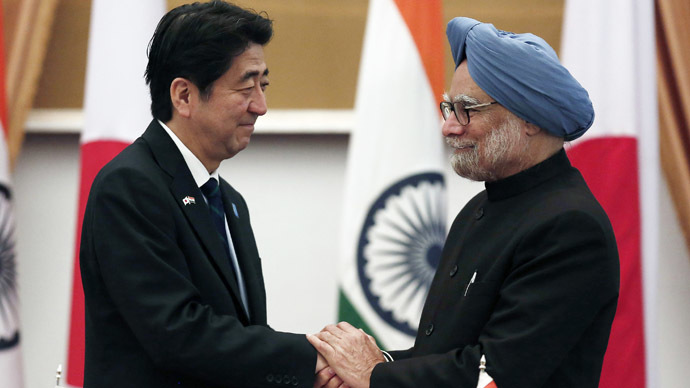
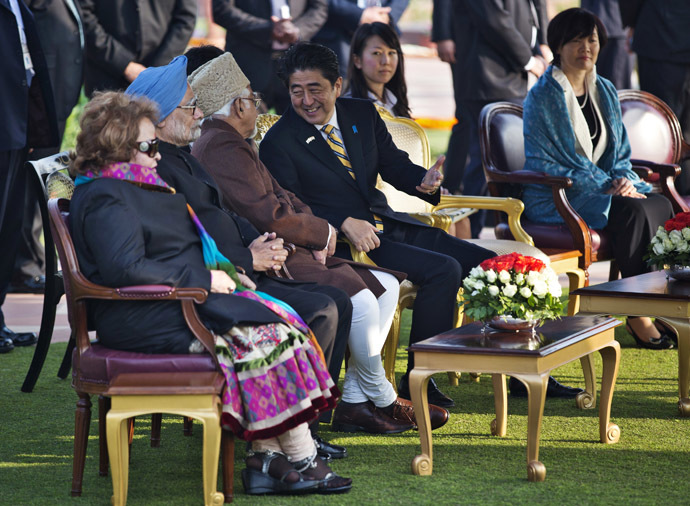
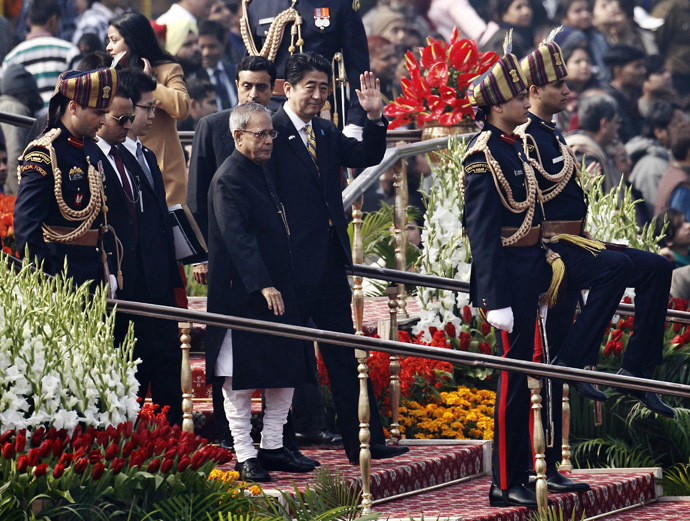
 Japan's PM visits controversial shrine
Japan's PM visits controversial shrine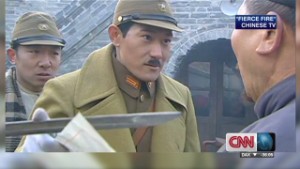 Actor helps China-Japan relations?
Actor helps China-Japan relations?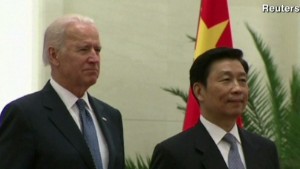 U.S.-China ties tested
U.S.-China ties tested Growth slowing down in India
Growth slowing down in India


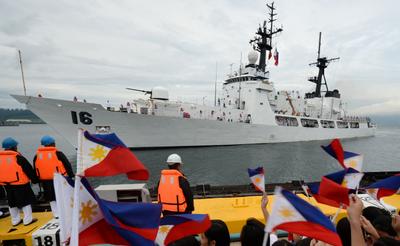





































No comments:
Post a Comment